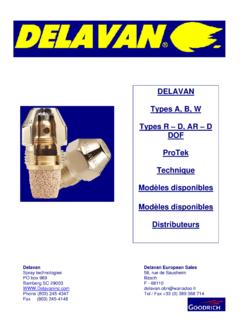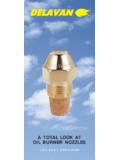Transcription of Fuel Nozzle For Oil Burners - Delavan Inc
1 fuel Nozzlesfor Oil BurnersTechnical Aspectsof ApplicationsBy E. O. Olson, Chief Engineer (deceased) Delavan fuel Meteing Products OperationBamberg, South Carolina-2-An oil burner is a combustion purpose is to promote efficient combustionof oil fuel . Mechanically speaking, there areseveral different types of oil Burners , such asvaporizing pot type, low pressure gun type,high pressure gun type, and several types ofrotary Burners . The fundamental processesupon which all of these different Burners arebased are the same, however. The process ofcombustion may be thought of in thefollowing steps:1.
2 The oil must be vaporized, since allcombustible matter must be converted toa vapor or gas before combustion cantake place. This is usually accomplishedby the application of The oil vapor must be mixed with air inorder to have oxygen present The temperature of the mixture must beincreased above the ignition A continuous supply of air and fuel mustbe provided for continuous The products of combustion must beremoved from the combustion simplest type of burner is thevaporizing pot type. In this type of burner ,heat is applied to a puddle of oil, causingvapors to be given off from the surface of thefuel.
3 These vapors are then burned aftermixing with the proper amount of it is desired to speed up thiscombustion process, the vaporizing processis accelerated by mechanical means. Thisis done by breaking the oil up into manyextremely small droplets. A very smalldroplet will, of course, be vaporized in anextremely short period of time whenexposed to high temperatures. Also byseparating the oil into very small dropletsthe surface area is increased, exposingmore oil surface to contact with air. Thesimplest method of doing this job withlight oils is by the use of nozzles, whichseparate the fuel into small droplets bytheir particular design.
4 We shall concernourselves here primarily with the highpressure atomizing type of nozzles sincethese are most common in the oil GPH Nozzle operating at 100 psi,spraying No. 2 fuel oil breaks the fuel up intodroplets, which have an average diameter ofapproximately .002 inch (50 microns). Thatmeans that one gallon of fuel is broken upinto something like 55,000,000,000 droplets,ranging in size from .0002" to .010" this process the surface area is increasedby approximately 3800 times. The resultantarea of one gallon of fuel is approximately690,000 square principal function of a Nozzle then isto break the fuel up into these very smalldroplets.
5 We use the term "atomize" todescribe this process even though it is notstrictly correct. The size of these droplets isvery important in the performance of aburner. Unfortunately there is as yet nocommercially feasible method of measuringdroplet sizes and all of the work that has beendone along that line has been on a addition to breaking up the fuel intosmall droplets, the Nozzle is expected todeliver these droplets in a specific pattern. Itmust be designed to deliver a specified sprayangle within specified limits.
6 It must also bedesigned to distribute these droplets asdesired across a cross section of the common distribution patterns are knownas hollow cone and solid cone and thesepatterns will be discussed second function of a Nozzle ismetering the fuel . On a normal high-pressureburner, it is customary to supply a fixedpressure to the Nozzle . It is also the practice ofnozzle manufacturers to calibrate nozzles at afixed pressure, usually 100 psi. At thepredetermined pressure the Nozzle must be sodesigned and dimensioned that it will delivera definite amount of fuel , within certainlimits.
7 Therefore the functional dimensions ina Nozzle must be controlled very must be available in a large numberof flow rates and spray angles to satisfy theneeds of the industry. For example, GPH, 21 different flow rates and 6 sprayangles are standard. Standards must also bemaintained both as to machining and as totesting, to insure that metering can bedepended upon year after A Nozzle WorksSeparation of oil into small dropletsrequires the application of energy. In the caseof nozzles, this energy is supplied in the formof pressure, usually from an appropriatelydesigned motor driven pump.
8 Pressure energyas such will not break up oil it must first beconverted into velocity energy. This is doneby supplying the fuel under pressure, usually100 psi on domestic Burners , and forcing itthrough a set of holes or slots. The oilemerges from these slots at very highvelocity. Figure 1 shows a schematic crosssection of a pressure-atomizing Nozzle of the"simplex" type. It will be noted that theseslots are cut tangentially into a swirl high velocity entering streams of oil setup a very high velocity rotation in the swirlFuel NozzlesFor Oil BurnersHow a Nozzle WorksFigure 1-3-chamber.
9 The velocity of rotation increases asthe liquid approaches the center of the swirlchamber so that if we place a dischargeorifice at the center of this swirl chamber wewill have the maximum rotational velocity inthat orifice. The velocity of rotation at thecenter is so high that an air core is created atthe center of the vortex. The oil then willextend into the orifice in the form of a rapidlyrotating tube of oil, leaving an air core in thecenter. As this tube of oil is rotating it pushesoutward against the walls of the orificebecause of the centrifugal force of the 100-psi pressure supplied at theslots is not converted into velocity of it remains as pressure energy and thepressure, which tends to push the liquidforward through the orifice, will beapproximately one half of the appliedpressure.
10 This pressure forces the oil toemerge from the orifice in the form of aspinning tube which, because of centrifugalforce, immediately expands into a coneshaped sheet as it leaves the orifice. Thissheet or film of liquid emerging from theorifice stretches to the point where it rupturesand throws off droplets of liquid. At lowpressure the velocity of this film is low and itextends a considerable distance in front of thenozzle before it breaks into large and irregularsize droplets. This can be seen in Figure 2. Asthe pressure is increased, as in Figure 3, 4,and 5, a definite spray angle is defined andthe droplets are smaller and more regular insize.


